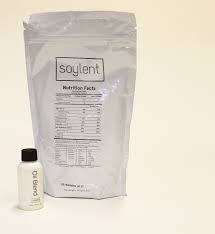 I recently found myself involved in a discussion of Soylent, a shake-like “food product” described on the product website as “a full day of balanced nutrition made in 3 minutes for $3/meal.” Created by a Silicon Valley software engineer, Soylent is designed to provide “maximum nutrition with minimum effort” by allowing consumers to drink a pre-prepared liquid instead of eating actual food at all or some of their meals. Several bloggers have tried it and written about their experiences. (Fortunately, I have a solid excuse for forgoing this exercise, as Soylent is not recommended for nursing women.) In scanning posts and comments on Soylent, it’s obvious that there’s a broad spectrum of opinions, particularly in regards to the health benefits vs. dangers of the product. I could probably write forever on that topic, but instead started thinking about this from another angle – could food-replacement products contribute to a healthier American food culture? I am admittedly biased in considering this question – I love buying, preparing, eating, and talking about food. I have a hard time understanding how anyone could want to eliminate food from their life. But that’s just my perspective, and I realize that there are many people out there who may have neither the interest nor the resources to obtain adequate amounts of nutritious food. For many Americans with limited time and resources, food has become yet another thing to economize – obtaining nourishment for the least possible effort and cost. Indeed, Soylent was born because its founder realized that he “resented the time, money, and effort the purchase, preparation, consumption, and clean-up of food was consuming.” Soylent can be purchased online and delivered right to your door, sparing you the walk or drive to the grocery store. You don’t have to expend any effort to prepare a meal, and with the recent release of “ready-to-drink” Soylent 2.0, even the step of mixing Soylent powder with a liquid has been eliminated. You can drink it while doing virtually anything else. This allows a true devotee of Soylent to eliminate nearly all of the time and effort formerly required to obtain and consume food.
The Soylent website claims that “Soylent’s nutritional profile has been optimized for the average adult human” based on vaguely referenced “recommendations of the Institute of Medicine (IOM)”. I am skeptical that a single product can actually achieve this, or that we can even define optimal nutritional requirements for an “average” adult. However, I also can’t argue that the typical diet of many Americans is anywhere close to optimal. So is it better to replace an unhealthy meal with a food product providing more essential nutrients? Could someone actually replace some or all of their meals with a powder or drink and live a healthy lifestyle? As nutrition scientists, we might hope to one day see everyone eating balanced, plant-based meals that we prepare ourselves using local, organic ingredients and consume slowly at a table while paying attention to our hunger and satiety cues. But really, is this a realistic goal? And if this is unattainable for the majority of Americans, should we be considering other alternatives to the fast-food drive-through? I don’t know the answers to these questions and am certainly not endorsing Soylent or other meal-replacement products. I do wonder, though, if it might be time to start thinking more creatively about solutions to the vast array of health problems that our existing food culture has created.
0 Comments
Your comment will be posted after it is approved.
Leave a Reply. |
©2017 WeighingInBlog. All rights reserved. 401 Park Drive, Boston, MA




 RSS Feed
RSS Feed

